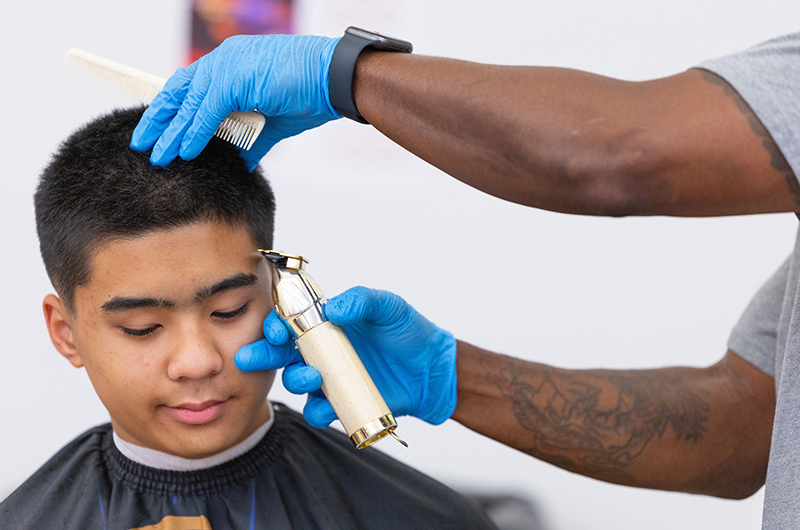Celebrating excellence
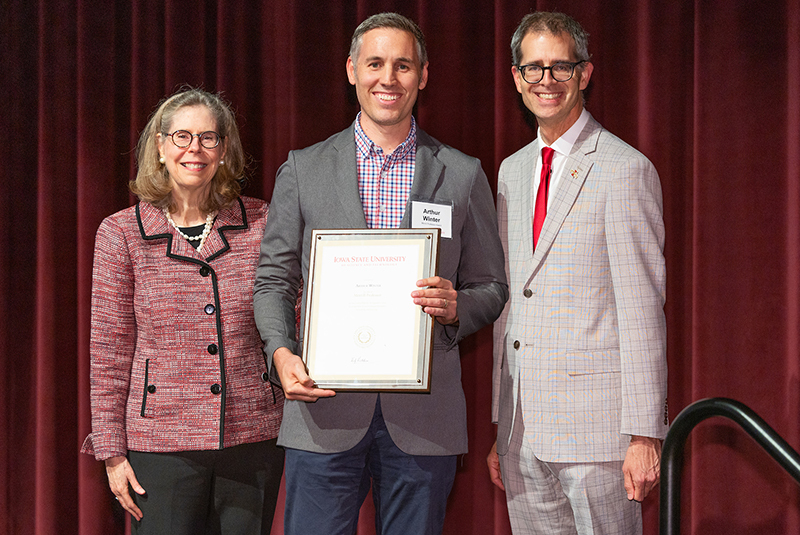
Arthur Winter, Morrill Professor of chemistry, received his award from president Wendy Wintersteen and provost Jason Keith. Photos by Christopher Gannon.
During a Wednesday afternoon ceremony at the Memorial Union, the university community honored the 62 individual and team recipients of this year's university awards, which recognize excellence in research, teaching, outreach to Iowans and service to students among Iowa State faculty and staff. To learn a little bit about each of the recipients, check out last week's edition of Inside Impact.

Jean Walsh, program specialist at the Pappajohn Center for Entrepreneurship, received the P&S Outstanding New Professional Award from senior vice president for operations and finance Sean Reeder and president Wendy Wintersteen.
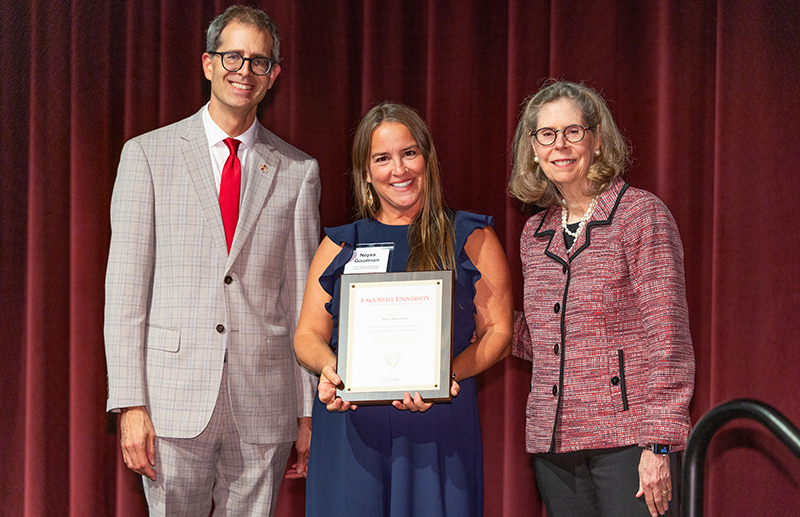
Neysa Goodman, associate teaching professor in world languages and cultures, received the Award for Outstanding Achievement in Teaching (Louis Thompson Distinguished Undergraduate Teaching designation) from president Wendy Wintersteen and provost Jason Keith.
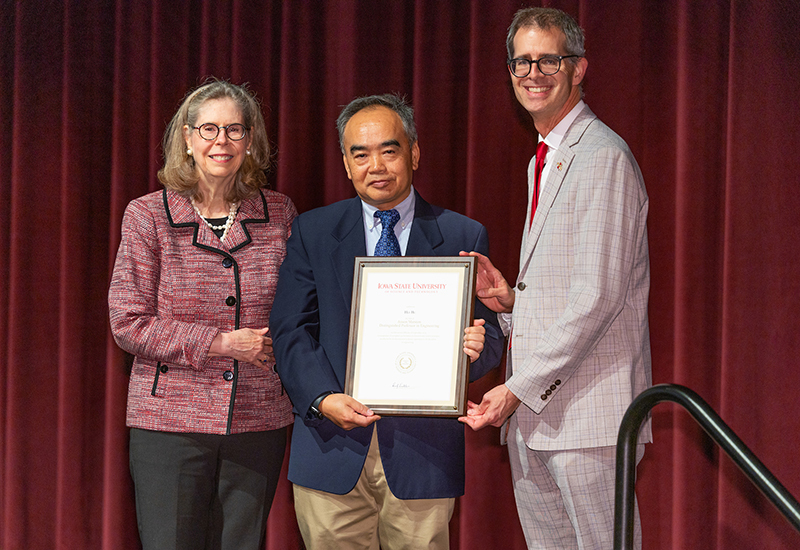
Hui Hu, Anson Marston Distinguished Professor in Engineering (aerospace engineering), received his award from president Wendy Wintersteen and provost Jason Keith.
Bookstore, library work to keep course material costs down
Iowa State continues to find ways to keep course materials affordable for students. The latest is Immediate Access ONE -- launched this fall -- which provides one course materials price ($259 for fall and spring, $69 winter and summer) for all undergraduate students.
On the first day of class each semester, students can access their required course materials by logging into Canvas. Students automatically are enrolled in the program and the savings is immediate.
"We saved students more than $2 million through Immediate Access ONE this fall," said ISU Book Store digital course material buyer John Wierson. "Last fall, we saved students just over $1.5 million with our previous program."
Combine that with open educational resources (OER) and course reserves through the University Library, and faculty play a significant role in affordability through the materials they choose.
"Using more free and low-cost materials keeps costs low for students," said Abbey Elder, open access and scholarly communication librarian. "The more instructors choose free and low-cost options, the more students it will impact by lowering the base fee -- or even allowing students to opt out of Immediate Access altogether."
Immediate access
Immediate Access ONE provides any required books, eBooks, course packets and lab manuals as well as homework platforms and access codes. Students also can pick up immediate access printed materials from the bookstore. Course supplies that aren't part of the program -- but available at the bookstore -- include lab coats, goggles and art and lab supplies. All printed items belong to the student unless they drop the course, and digital materials are added and removed automatically from Canvas as students add or drop courses.
Wierson said about 3,100 (12.1%) of Iowa State's 25,628 undergraduates opted out of the program this fall, which was below the bookstore's estimate of 15%.
"For those students who opted out, it was most likely because their combined course materials cost less than $259," he said.
Students have until the 10th day of the semester to opt out and receive a refund to their U-Bill. Students who opt out still can buy materials through the bookstore to use their financial aid or choose a different vendor.
Wierson said bookstore staff will review Immediate Access ONE data from the 2024-25 academic year to determine if tweaks are necessary to the flat-rate cost next year. This includes targeting titles with higher prices where additional publisher pricing negotiations are needed to help keep the overall flat rate-cost down, which could result in lower opt-out rates.
Open educational resources
OER are instructional materials that are free to access and customize. Iowa State is the leader in OER among the three regent universities, saving students $2.5 million since 2018. During that same time, the University of Iowa's OER student savings was $1.8 million and Northern Iowa students saved $1.5 million.
More OER discussion
University library is hosting a series of in-person events about OER and affordable course materials in 1118 Student Innovation Center; Register online.
OER often are thought of as free textbooks, but they can be videos, lesson plans, recorded lectures and more.
The key to increasing OER use is making faculty aware of the support available to them, Elder said. Faculty interested in finding an OER or developing their own can contact their subject librarian at Parks Library. Elder also is available to meet with individual faculty or present to larger groups. Faculty members already using their own materials also can work with the ISU Digital Press to produce and publish the material. About 10 OER books are produced at ISU each year, Elder said. Two books were just published for the start of class this fall, including a lab manual for human anatomy.
"A big misconception is that something can't be good if it's free," she said. "Just because something is free to access doesn’t mean it's free to create, because it takes time, effort and many people working together to make it happen."
Elder, who serves as the statewide open education coordinator for public universities, private colleges and community colleges, said about 40 ISU courses -- and even more sections -- currently use OER materials.
Course reserves
Course reserves is another service of the University Library that helps instructors use low- and no-cost course materials. Course reserves can include digital or print books, book chapters, journal articles, videos and more. Items used for assignments or covered on tests are candidates for course reserves. Digital materials are loaded into Canvas and available to students 24/7, and print materials are listed there for easier trips to the library.
The library ensures all material meets accessibility standards and pays reasonable copyright fees as required, said course reserves supervisor Jill Vasquez.
In fiscal year 2024, 328 courses used course reserves, saving students $10,263 in required course materials. University Library also paid more than $16,000 for copyright law compliance.
Last year, course reserves began offering time-controlled digital lending for out-of-print books. A partnership with the ISU Book Store led to identifying and making available course packet materials from library subscriptions and collections.
Faculty can make course reserve requests anytime during the semester but are asked to provide at least four weeks' notice before students need access to the materials. Requests can be submitted in Canvas and questions about course reserves can be emailed to ereserve@iastate.edu.
Payroll timing change takes effect next week for salary nonexempt staff
Beginning Oct. 1, Iowa State's merit, contract and professional and scientific (P&S) employees and postdoctoral scholars in salary nonexempt positions will change to hourly nonexempt positions and be paid twice a month. University human resources (UHR) first shared this change in late May.
Impacted employees' compensation is not changing. Their current annual salaries will show up as an hourly rate in Workday, but their base pay is not impacted.
The change creates a consistent payment schedule for all nonexempt employees at Iowa State. Salaried nonexempt employees, once converted to hourly nonexempt, will continue to track their hours worked and time off in Workday, and a weekly submission for manager's approval remains the minimum expectation.
FAQ
Transition to semi-monthly pay schedule for salary nonexempt
The federal Department of Labor sets guidelines for nonexempt positions, and staff in ISU's general counsel and university human resources offices apply them to university positions. As of this month, the change impacts an estimated 470 merit and 480 P&S employees. It also impacts a handful each of contract employees and postdoctoral scholars.
Transition payment in October
The transition from a monthly to semimonthly pay cycle creates a two-week lag in pay, so to assure their 2024 salaries aren't diminished, impacted employees will receive a one-time transition payment at the end of October. For them, the month will look like this:
- They will receive a paycheck on Oct. 25 for hours worked Oct. 1-15.
- They will receive a one-time transition payment on Oct. 31, equivalent to 88 hours of pay for full-time employees and prorated for part-time employees. This payment, intended to bridge the gap in their earnings during the transition period, will be distributed the same as a payroll check.
- They will receive a paycheck on Nov. 8 for hours worked Oct. 16-31.
Once semimonthly pay is fully implemented in November, nonexempt employees will be paid twice a month for actual hours worked during two pay periods: Days 1-15 of the month and days 16-last day of month. Illustration of transition. UHR shared a breakout of payroll deductions -- for example, insurance premiums, charitable deductions or parking permit payments -- between the two paychecks.
"We encourage impacted employees and their supervisors to familiarize themselves with the materials. Employees need to take action to make sure they have their personal finances set up for two paychecks each month instead of one," said Kristi Darr, vice president for university human resources.
Emails to those impacted
Impacted employees, their supervisors and administrative officers received reminder emails about this change Sept. 10 from university human resources leaders. Via a Sept. 13 Workday to-do task, impacted employees were asked to acknowledge they understand their payroll will change to semimonthly.
Benefits to the increased pay frequency include:
- Removing the guesswork from the last few days of the month. Employees are paid for actual time they've worked, rather than for days yet to be worked. This change will reduce the over/under payments for employees who make changes during the final few days of the pay cycle.
- More effective budgeting for units.
- ISU's payroll team spends less time processing off-cycle overtime checks.
Questions about the change may be emailed to semimonthly@iastate.edu.
Iowa State Safe, trainings promote safety on campus
With new faculty, staff and students getting settled on campus this fall, it is a good time for a reminder that the department of public safety provides technology and trainings to promote safety for everyone at the university.
Assistance in the palm of your hand
The Iowa State Safe app launched in January 2023 with a variety of safety options, and more campus information continues to be added. Users can download it for free through the Apple App or Google Play stores. Faculty, staff and students can use the app by signing in with their Net-ID and password -- which imports information to autofill when service is requested -- or as a guest. Campus visitors also can use the app as a guest.
Some of the most used safety features are:
Mobile BlueLight: The one-touch button acts as a silent alarm when the user feels unsafe. "When the button is pushed, the signal is sent to ISU dispatch where they see who pushed the button and their location on campus," said Nick Swanson, department of public safety key and emergency management director. "Dispatch will call the individual, and an officer also is sent to the location."
Friend walk: The user sends a text to a friend telling them where they are walking to on campus and the friend monitors progress along the route through Google Maps.
Virtual walkhome: Operates like friend walk, but ISU dispatch receives the notification and monitors the individual.
988 suicide and crisis helpline: Connects the user to trained counselors with the Lifeline network for those dealing with mental health struggles, emotional distress, alcohol or drug use concerns, or just need someone to talk to.
SafeRide: Users can request a ride on campus from 6 p.m. to 5:30 a.m. daily. Using the app -- instead of calling in a request -- provides a more accurate pickup point for the escort. The SafeRide tile only appears in the app during active hours of the service, and rides can only be given from one campus location to another.
"It is important to know that SafeRide can be in a car, golf cart or an officer may walk to you on campus and escort you to your destination," Swanson said.
Safety toolbox: Users can chat with ISU police, share their location with friends or report an incident, like a slip or fall.
Users also can submit crime tips, request help with a locked vehicle, report a nonemergency crime, or contact the mental health advocates and request the therapy dogs through the app.
"We set up the app to help users find a campus resource and be able to contact them with a push of a button that sends the number to your phone with no copying and pasting," Swanson said. "Most departments also have a one-touch email button that links to your default email."
More information
Swanson said additional features have been added for quick access to useful information, for example, health resources, CyRide, ISU Dining, SHOP food pantry and more. He also gathered information for residence move-in that helped parents and students quickly locate hall desk locations, find move-in parking and provide quick access to campus maps.
"We're always looking to add more information that is helpful to campus, and we did see about a 500 person bump in downloads during move-in," said Swanson, who noted the app has been downloaded more than 8,200 times since its launch 20 months ago.
Trainings for campus employees
Members of the ISU police department lead a range of safety trainings that departments and units can schedule by emailing isupdoutreach@iastate.edu. Some of their most requested are:
Recognizing and Reporting Disruptive Behavior: Focuses on recognizing the warning signs of escalating and disruptive behavior and teaches ways to mitigate potential acts of violence before the problem becomes unmanageable. Proactive approaches are stressed over reactive ones. Training lasts one to two hours.
Violent Incident Response Training (VIRT): Promotes an options-based response and teaches a flexible set of principles that may be adapted to any violent encounter. Based on the principles of avoid, deny, defend, it provides options to help you survive a violent situation. Training lasts one-and-a-half to two hours.
Office Space Assessment: Educates faculty and staff about best practices for safety in their offices and workspaces. Based on the principles of crime prevention through environmental design, these sessions discuss techniques and options for arranging an office space, adding elements of security and developing a plan for yourself and colleagues.
Safety Planning: Helps identify tools and resources individuals already possess to keep them safe while also helping them identify additional resources they may need. It addresses emotional, psychological and physical safety risks and is individualized.
Assistant police chief Carrie Jacobs said faculty and staff have access to resources to de-escalate situations, but aren't always trained to use them effectively. She encourages departments and units to consider taking training yearly or whenever new faculty or staff arrive.
"VIRT is our most popular training -- and you can take it with you wherever you go -- but we want people to take Recognizing and Reporting Disruptive Behavior (RRDB) first," she said. "It is tailored specifically for faculty and staff.
"We know that faculty can be hesitant to use what is available to them because they don't want to offend or infringe on student rights," Jacobs added. "RRDB really helps them learn how to effectively approach and help a student, especially if a student is in a crisis."
Jacobs said faculty can talk with an officer without divulging the student's name.
Rural economy, Iowa businesses would benefit from new state support
Iowa State will seek nearly $11.8 million in additional appropriations from the state in the year that begins July 1, 2025. The state Board of Regents sends the universities' appropriations requests to the state by Oct. 1 each year, and President Wendy Wintersteen shared Iowa State's requests with board members during their Sept. 19 meeting in Ames.
The university is not asking for an increase to its general university operating support. Instead, its seven requests are grouped around two focus areas: Enhancing Iowa's rural economy and supporting Iowa businesses. The seven are:
Enhancing Iowa's rural economy
- Incremental operations funding for the Ag Experiment Station ($3.75 million) and Cooperative Extension ($1 million) to help maintain the state's agricultural competitiveness and explore opportunities for growth. Three proposed focus areas are: agricultural workforce and entrepreneurship, digital and precision livestock and crops, ag economics policy and training.
- New support ($4 million) to open four manufacturing hubs in partnership with regional educational institutions and create new avenues for students and manufacturing employees to complete four-year and advanced degrees. Funding would upgrade existing training centers with advanced technologies and update and align curricula. The name for the concept is MakeIowa.
- New support ($1 million) for scholarships that assure in-state tuition at the College of Veterinary Medicine for up to 10 students/year accepted into the ISU Production Animal – Veterinary Early Acceptance Program established in 2023. Upon graduation, the scholarship would be forgiven if a veterinarian worked for five years as a food animal veterinarian in rural Iowa.
- Incremental support ($250,000) for livestock disease research, to leverage even more external research funding and combat threats to the state's livestock industry.
Supporting Iowa businesses
- Incremental operations support ($1.5 million) for the Veterinary Diagnostic Laboratory (VDL), particularly its new Biosafety Level 2 facility. Current appropriations and the lab's fee income can't cover this expense. Wintersteen noted that 16% of the VDL's operating budget comes from state appropriations, compared to an average 48% at other VDLs.
- New support ($250,000) for staff and operations in entrepreneurship, for example, competition prizes, travel to national conferences and competitions for students and professional mentoring for faculty.
- Additional support ($36,000) to reach a total of $3 million annually ($1 million each) for the three state bioscience platforms based at Iowa State (biobased products, vaccines and immunotherapeutics, and digital and precision agriculture), getting to the funding goal established in 2017 when the initiative launched.
Read more
Other Iowa State items on the regents' September meeting agenda
In addition, the board will send to the state a $30 million capital request in FY 2026 for deferred maintenance projects at the three universities. Each university has projects that would be priorities for these funds.
Associate vice president for facilities management Wendy Kisch shared a five-year, $32 million proposal (using $7 million of the $30 million request) to renovate Atanasoff Hall for the computer science department, which offers one of Iowa State's largest undergraduate majors (983 in fall 2023). Additionally, computer science courses increasingly are requirements for majors in other programs.
Completed in 1969, Atanasoff still has most of its original systems, and labs and offices are outdated.
Campus inclusion reviews
In other business, board president Sherry Bates said a coordinated review began this summer of offices and positions doing work related to diversity, equity and inclusion (DEI) on the three regent campuses, as required by the spring 2024 education appropriations legislation. The bill, commonly referenced as Senate File 2435, includes new sections that restrict diversity, equity and inclusion efforts at the three regent universities. Those restrictions take effect July 1, 2025. Regents Bates, David Barker, JC Risewick and Greta Rouse are working with board office and university staffs to comply with the law.
Bates said the group will complete its work by Dec. 31. Their process at each university:
- Identify and understand relevant state and federal law and accreditation requirements.
- Conduct a unit-by-unit analysis of units and positions, both central and distributed.
- Identify DEI programs, units and positions "provided for" by law or accreditation.
- Identify DEI programs, units and positions that require additional review and potential action.
"We are aware there are instances, events or programs that can be perceived as going too far. As we learn of them, we review them in the light of the law and address them appropriately," Bates said. "That's been our practice in the past and will continue to be our practice in the future."
At the Nov. 7 regents meeting, she said the board will receive a progress report on the review, relative to the Dec. 31 targeted deadline.
More frequent teeth cleanings are an option for some
The benefits team in university human resources reminds employees that dental health is an important component of overall health management. Employees are encouraged to make the most of the preventive care covered by the Delta Dental benefit -- that's two cleanings, one fluoride treatment and a set of x-rays each year for most of us. Some employees are eligible for additional cleanings.
Iowa State employees use their dental benefit fairly well, as illustrated by these data points:
- In the current plan year, 91% of benefits-eligible employees are enrolled in the dental plan.
- During plan year 2023, 77% of enrolled participants had at least one cleaning.
- Also during plan year 2023, 59% of ISU total claims were for preventive and diagnostic (X-rays, screenings) services. Well down the list were routine fillings (13%) and cast crowns (11%).
Dental sleuthing
What some might not realize is that a dental exam can reveal more than a loose filling. During their probe of a mouth, an oral hygienist or dentist could observe symptoms related to more than 120 medical conditions, things like diabetes, HIV, infections, oral cancer, heart disease or osteoporosis. Routine checkups can uncover skin diseases, thyroid problems or an early stage of hardening of the arteries because dentists and oral hygienists may see symptoms in your mouth that you might not notice or simply aren't able to detect. And early detection is key to successfully treating many conditions.
More frequent cleanings are possible for some
Recognizing the link between oral health and overall health, Delta Dental's plan allows participants with certain health conditions to receive two additional teeth cleanings during the plan year. Those conditions include diabetes, kidney failure/dialysis, periodontal/gum disease, suppressed immune system and individuals receiving chemotherapy or radiation treatments. Pregnant women may receive one additional cleaning.
To receive these additional free benefits, plan participants must add themselves to the Enhanced Benefits Program on the Delta Dental of Iowa website (register first in the member connection if you haven't done that previously). Step-by-step instructions are provided.
If you need to choose a dentist, consult this list, and schedule an appointment soon. Among Iowa dentists, 90% are in the Delta Dental network. Among ISU plan participants, 94% go to an in-network dentist.
Haircuts in an unlikely location
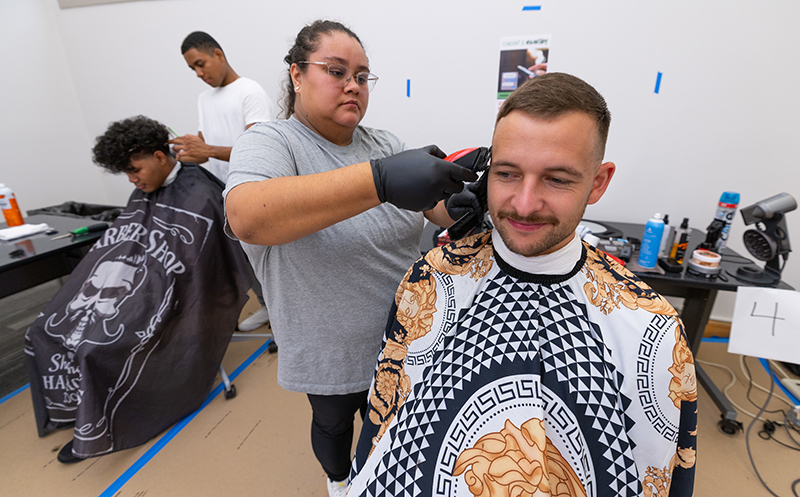
Michael Bayer, a graduate student in mechanical engineering, receives a haircut from Samantha Hernandez, a Des Moines barber, in Parks Library's Cyclone Support Central Tuesday morning. Photos by Christopher Gannon.
Tucked away in a multipurpose space at Parks Library Tuesday, six barbers from the Des Moines area, working for nearly six hours, completed haircuts for 56 Iowa State students. ClipDart, a national not-for-profit started by a Grinnell College alumnus, provides free haircuts, mostly for college student and senior audiences, as a mental wellness service. Tuesday's haircut fest was the first of four scheduled this semester and open to all students (two October dates and one November date are nearly filled).
It also launched a collaboration between the division of student affairs' Cyclone Support programming and University Library's Cyclone Support Central, a physical hub on the library's main level. The venue also will be the place for flu shot clinics for students on Oct. 1, 15 and 29; and drop-in wellness activities throughout the semester hosted by Student Health and Wellness. An emerging trend nationally is for academic libraries to offer spaces for student wellness.
Costs for the haircut events with ClipDart are being shared by Student Health and Wellness, Multicultural Student Affairs, First Scholars program and TRIO Student Support Services, with in-kind support from University Library.
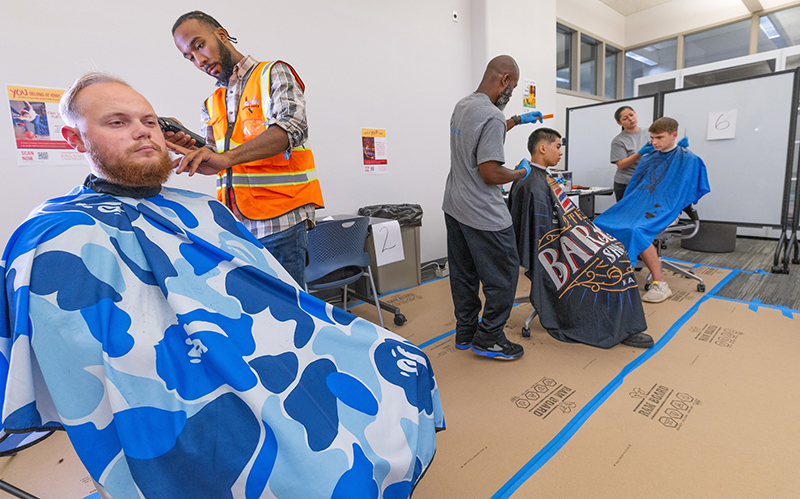
(left) Senior Hunter Pope, a supply chain management major, receives a cut from barber John Martin of Des Moines.
